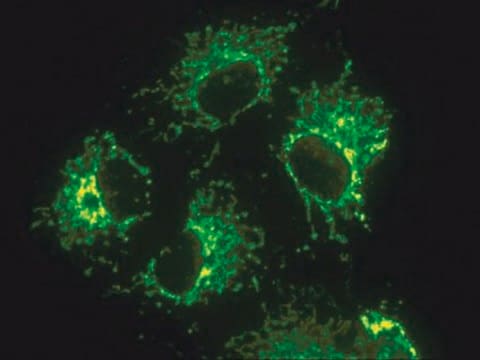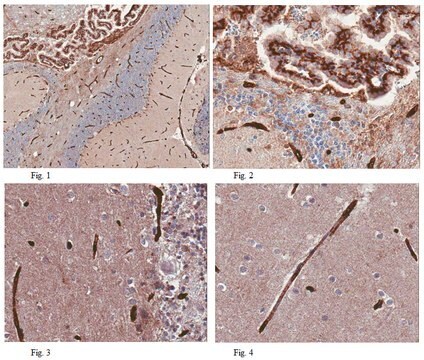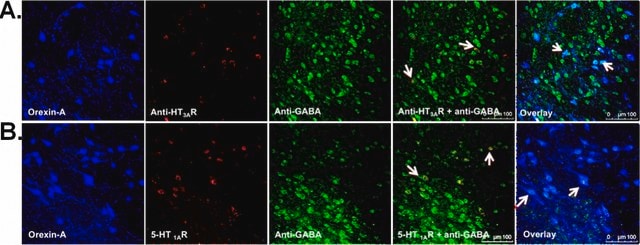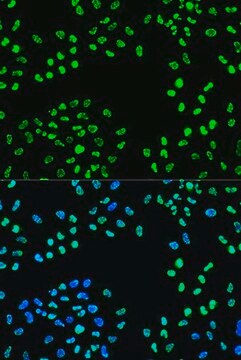おすすめの製品
由来生物
rabbit
品質水準
抗体製品の状態
diluted serum
抗体製品タイプ
primary antibodies
クローン
polyclonal
化学種の反応性
rat
メーカー/製品名
Chemicon®
テクニック
immunohistochemistry: suitable
輸送温度
wet ice
ターゲットの翻訳後修飾
unmodified
特異性
Glycine. The antibody has been calibrated against a spectrum of antigens to assure hapten selectivity and proper affinity. No measurable cross-reactivity (<1:1000) against glycine in peptides or proteins. No measurable glutaraldehyde-fixed tissue cross-reactivity (<1:1000) against L-alanine, gamma-aminobutyrate, 1-amino-4-guanidobutane (AGB), D/L-arganine, D/L-aspartate, L-citrulline, L-cysteine, D/L-glutamate, D/L-glutamine, glutathione, L-lysine, L-ornithine, L-serine, taurine, L-threonine, L-tryptophan, L-tyrosine.
免疫原
Glycine-glutaraldehyde-BSA
アプリケーション
Research Category
ニューロサイエンス
ニューロサイエンス
Research Sub Category
イオンチャネル及びトランスポーター
イオンチャネル及びトランスポーター
Detect Glycine (Low Glutaraldehyde) using this Anti-Glycine (Low Glutaraldehyde) Antibody validated for use in IH.
Immunohistochemistry using silver-intensified immunogold or fluorescence (see recommended protocol). Samples should be fixed with 0.5% - 2.5% glutaraldehyde for optimum detection.
*This antibody has also been used and found to work with a zero-low glutaraldehyde / high paraformaldehyde fixation (4% paraformaldehyde in 0.1M phosphate buffer / 3% sucrose fixative). The minimum glutaraldehyde concentration for AB5020 is 0.05%. See protocol that follows. Performance is good with frozen sections, Vibratome sections and tissue culture formats, when penetrating reagents such as 0.3% Triton X-100 are used.
Optimal working dilutions must be determined by the end user.
DILUTION: Prepare enough of the AB5020 for your days use by diluting 100X with 1% GSPBT.
*This antibody has also been used and found to work with a zero-low glutaraldehyde / high paraformaldehyde fixation (4% paraformaldehyde in 0.1M phosphate buffer / 3% sucrose fixative). The minimum glutaraldehyde concentration for AB5020 is 0.05%. See protocol that follows. Performance is good with frozen sections, Vibratome sections and tissue culture formats, when penetrating reagents such as 0.3% Triton X-100 are used.
Optimal working dilutions must be determined by the end user.
DILUTION: Prepare enough of the AB5020 for your days use by diluting 100X with 1% GSPBT.
包装
2000 assays
物理的形状
IgG fraction in sterile 0.1M phosphate buffer. No preservative
保管および安定性
Maintain stock at 2-8°C in undiluted aliquots for up to 6 months. This stock is extremely stable under normal use and routine storage at 2-8°C. Do not freeze this stock.
法的情報
CHEMICON is a registered trademark of Merck KGaA, Darmstadt, Germany
免責事項
Unless otherwise stated in our catalog or other company documentation accompanying the product(s), our products are intended for research use only and are not to be used for any other purpose, which includes but is not limited to, unauthorized commercial uses, in vitro diagnostic uses, ex vivo or in vivo therapeutic uses or any type of consumption or application to humans or animals.
Not finding the right product?
Try our 製品選択ツール.
試験成績書(COA)
製品のロット番号・バッチ番号を入力して、試験成績書(COA) を検索できます。ロット番号・バッチ番号は、製品ラベルに「Lot」または「Batch」に続いて記載されています。
Nadia Parmhans et al.
The Journal of comparative neurology, 526(4), 742-766 (2017-12-09)
We report the retinal expression pattern of Ret, a receptor tyrosine kinase for the glial derived neurotrophic factor (GDNF) family ligands (GFLs), during development and in the adult mouse. Ret is initially expressed in retinal ganglion cells (RGCs), followed by
Franz Weber et al.
Nature, 526(7573), 435-438 (2015-10-08)
Rapid eye movement (REM) sleep is a distinct brain state characterized by activated electroencephalogram and complete skeletal muscle paralysis, and is associated with vivid dreams. Transection studies by Jouvet first demonstrated that the brainstem is both necessary and sufficient for
Optogenetic perturbation of preBotzinger complex inhibitory neurons modulates respiratory pattern.
Sherman, D; Worrell, JW; Cui, Y; Feldman, JL
Nature Neuroscience null
Lisa Nivison-Smith et al.
PloS one, 8(3), e58406-e58406 (2013-03-22)
Lampreys are one of the two surviving groups of the agnathan (jawless) stages in vertebrate evolution and are thus ideal candidates for elucidating the evolution of visual systems. This study investigated the retinal amino acid neurochemistry of the southern hemisphere
Takahiro Tsuji et al.
The Journal of physiology, 595(11), 3497-3514 (2017-04-13)
A subpopulation of retinal ganglion cells expresses the neuropeptide vasopressin. These retinal ganglion cells project predominately to our biological clock, the suprachiasmatic nucleus (SCN). Light-induced vasopressin release enhances the responses of SCN neurons to light. It also enhances expression of
ライフサイエンス、有機合成、材料科学、クロマトグラフィー、分析など、あらゆる分野の研究に経験のあるメンバーがおります。.
製品に関するお問い合わせはこちら(テクニカルサービス)






